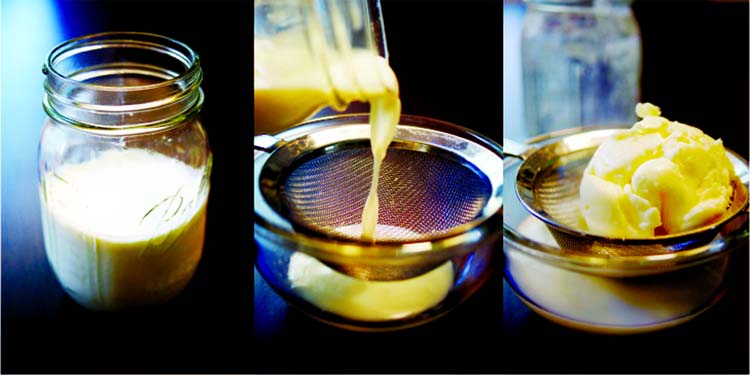
Weekend Plus Desk :
Think of making butter at home and the image of sari-clad women with sweat-beaded brows, labouring underneath the sun with a churner and a big butter bucket comes to mind. Which is why most of us would rather hop across to a store and buy a slab of butter, than try making it at home.
To realise how easy it is to make butter, all you need to do is understand the science behind creating butter.
The cream in milk contains fat globules (think microscopic water balloons). The more the globules, the thicker the cream is. When shaken together, the fat molecules bump against each other and come apart like bursting water balloons. The spilt fat then clumps with fat from other globules. As this process continues, two new substances are formed: a solid (butter) and the remaining liquid (buttermilk).
Thanks to modern gadgets, making butter at home couldn’t be easier. Also, it’s just healthier to make it at home – not to mention, way cheaper. Also, once you’ve tasted the fresh, creamy, foamy light texture of butter whipped at home, there’s no going back to processed and mass-produced butter.
Here is how you can make your own butter at home:
* Take a blender and fill it halfway with heavy cream.
* If you’re looking to go really traditional, you can shake the cream in a jar also.
* Turn the blender on medium-high.
* Once you see the pieces of butter cream hitting against the sides of the blender that is the stage when the cream is getting thicker.
* Finally, the whole thing will become liquid. This is the stage when butterfat separates from buttermilk.
* Scoop out the butterfat and your homemade butter is ready.
* You can eat the fresh butter as is but if you want it to last longer, you need to wash out the excess buttermilk from it.
* For that, scrape your butter into a dish of ice cold water.
* Squeeze and knead the butter to get the buttermilk out.
* Continue washing your butter and changing you water until the water is clear. It might take six to seven changes of water.
* Pat the butter dry or a muslin towel or a paper towel. n
Think of making butter at home and the image of sari-clad women with sweat-beaded brows, labouring underneath the sun with a churner and a big butter bucket comes to mind. Which is why most of us would rather hop across to a store and buy a slab of butter, than try making it at home.
To realise how easy it is to make butter, all you need to do is understand the science behind creating butter.
The cream in milk contains fat globules (think microscopic water balloons). The more the globules, the thicker the cream is. When shaken together, the fat molecules bump against each other and come apart like bursting water balloons. The spilt fat then clumps with fat from other globules. As this process continues, two new substances are formed: a solid (butter) and the remaining liquid (buttermilk).
Thanks to modern gadgets, making butter at home couldn’t be easier. Also, it’s just healthier to make it at home – not to mention, way cheaper. Also, once you’ve tasted the fresh, creamy, foamy light texture of butter whipped at home, there’s no going back to processed and mass-produced butter.
Here is how you can make your own butter at home:
* Take a blender and fill it halfway with heavy cream.
* If you’re looking to go really traditional, you can shake the cream in a jar also.
* Turn the blender on medium-high.
* Once you see the pieces of butter cream hitting against the sides of the blender that is the stage when the cream is getting thicker.
* Finally, the whole thing will become liquid. This is the stage when butterfat separates from buttermilk.
* Scoop out the butterfat and your homemade butter is ready.
* You can eat the fresh butter as is but if you want it to last longer, you need to wash out the excess buttermilk from it.
* For that, scrape your butter into a dish of ice cold water.
* Squeeze and knead the butter to get the buttermilk out.
* Continue washing your butter and changing you water until the water is clear. It might take six to seven changes of water.
* Pat the butter dry or a muslin towel or a paper towel. n

